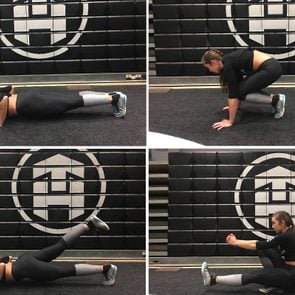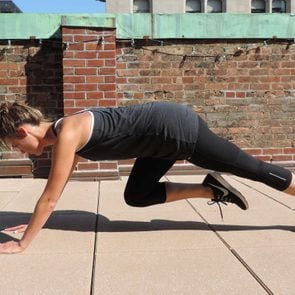Here’s How and Why You Need to Engage Your Core
Updated: Mar. 29, 2021
Core engagement is more than just ab workouts. Learn how to engage your core through contraction and controlling your pelvis for strength.
All about a strong core
If you exercise at all, you’ve likely heard about the importance of core work—”a strong core prevents back pain,” “strengthen your core to become a better athlete,” “get the beach body core you’ve always dreamed of.”
So is “the core” just the latest slang for “abs” or is it something more? And is core work really as important and all-powerful as the social media advertisements would have you believe?
Actually, yes. But core work isn’t just referring to strengthening the six-pack muscles of your abdomen.
It’s a much more complex muscular system that connects and transfers powerful energy and movement between your upper and lower body, while also providing for stability and control. Here’s what you need to know about engaging your core.
What is “the core?”
“I think of the core as anything that attaches to the spine, including your neck,” says Eni Kadar, a licensed orthopedic physical therapist and founder of Holistic DPT. “It’s foundational for all functional movements, so it’s important for our core to function properly in order to avoid pain, injuries, and unnecessary wear and tear on our bodies.”
And the thing to remember is that a lot of muscles, tendons, and ligaments attach to the spine. This includes your glutes, the spinal erectors, all four major muscle groups of your abdomen, your pelvic floor, diaphragm, and even the larger muscles of your upper back and shoulders, including the lats, traps, and rhomboids.
The glutes play a role in maintaining stability and control through your spine, pelvis, and abdomen.
(These are the everyday habits that are damaging your spine.)
The core as part of a larger movement system
When working as part of your larger movement system (the kinetic chain), your core muscles help transfer energy and power from your upper body to your lower body, and vice versa.
“Because every movement is connected in a chain within our bodies, core stabilization is important for anybody trying to improve their function—not only those with back pain!” explains Kadar.
That’s why the advertisements or promotions that claim core strength is the key to athletic performance are actually incredibly accurate (although that doesn’t mean you need to run out and buy that trainer’s program).
Marian Barnick, a registered kinesiologist who works in Toronto, explains the concept of the kinetic chain by using the example of baseball.
“If you watch a baseball pitcher wind up before he releases the ball, you can see that he’s using his whole body to create the force to throw that fastball,” Barnick says. “His core is key to not only power generation through muscular contraction, but also transferring that power from his legs through to his shoulder and arm.”
And it’s not just in sports where you can see this happen. If you drop something on the floor and you lean forward, lifting one foot off the ground to pick it up, your core is controlling the movement.
The core is allowing this transfer of energy from your leg, through your hips, abdomen, back, and shoulder, to your arm. Then, it uses your core muscles to provide the stability and strength to return to standing without falling over.
It’s in movements like this where you can also see how a weak core can cause problems and pain in the back.
“When your core is weak, your body compensates because of the postural and alignment changes, and this means other muscles are forced not only to work harder, but in a role that they weren’t designed to perform,” says Barnick. “This compensation not only decreases performance, but leads to symptoms of tightness, pain, and eventually injuries if not corrected.”
(Try these at-home workouts for a stronger core.)
Identifying a weak core
So how do you know if your core needs some work? Generally speaking, most people who sit for long periods of time throughout the day, those who tend to have poor posture, or who work desk jobs could probably use some extra core attention. But that’s not a hard-and-fast rule.
“Pain is usually our first indicator,” says Kadar. “It should also be understood that a weak core can also mean a poorly coordinated core. Some people are shocked to find they can rep out 50 abdominal crunches, but when asked to hold a neutral posture using small stabilizer muscles it becomes challenging and awkward.”
(Have low back pain? Try these back pain exercises.)
And checking on coordinated movements (i.e., how your kinetic chain is working) is another way to assess core strength.
“Transferring from one position to another, whether it’s from sitting to standing or getting up from the floor is a great way to see if your core is working well at supporting your body,” says Barnick.
“If you can transfer with a neutral spine, your core is working well. If you need to bend and twist, hold onto something, and use your arms to push, then your core isn’t optimized and can probably use some work.”
Improving core engagement and strength
The thing about your core is that you use it all day, every day. As such, you don’t have to be at the gym or in the midst of an exercise session to work on improving your core engagement and strength. In fact, Kadar points to simple contraction and pelvic control as an easy way to work your core throughout the day.
“I’ll often have my patients practice finding a ‘neutral’ posture by tilting their pelvis while they lie on their back with their knees bent. From there, they’ll contract their abdominal muscles gently and hold the contraction as long as they can.” she says.
But she adds that it’s not the type of contraction where you’re holding your breath as well. You should be able to continue breathing deeply while maintaining the contraction.
Once you’ve mastered the contraction and hold while lying on your back, you can start practicing the same contraction as you sit, stand, or move around. And it’s a good idea to give yourself a “trigger” to remind yourself to work your core, even when you’re not working out.
“It can be as simple as each time you reach for your water bottle or coffee cup,” says Barnick.
“Take a split second to be aware of your body alignment. The more you build awareness of the proper body positioning, the easier it is to have your brain fire the right muscles, all without breaking a sweat.”
(This 10-minute core compression routine will help you strengthen the core.)
Exercises to engage your core
And of course, when you exercise, you can’t forget to work your core muscles. Because the core is built for endurance, you can train these muscles more often—as much as daily if you want. Just remember, your core is a part of every compound movement you perform, whether you’re doing squats, pushups, or pullups.
This is why core engagement (holding that tight, neutral, contracted position of all your spine-attached muscle groups while still being able to breath) is so important for every exercise you perform.
So even if it’s not “ab day” and you’re not cranking out a thousand sit-ups, you can still work your core.
(Try these exercises to work your abs without doing crunches.)
Consider adding the following moves to your regular workout routine to build endurance, stability, coordination, and strength through all the muscles of your core.
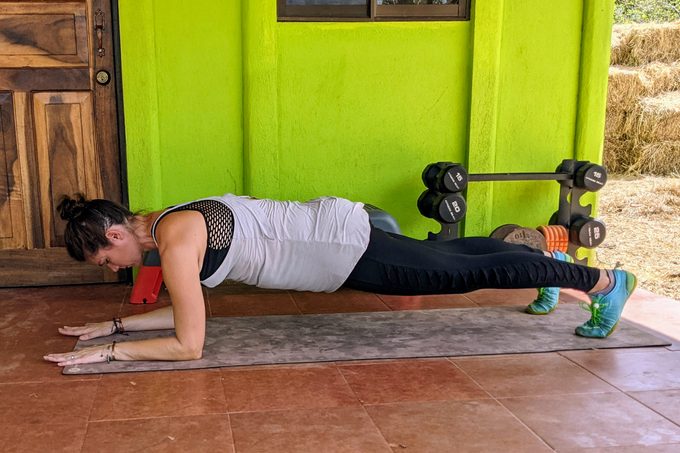 Plank
Plank
The plank targets all the major muscle groups of your core, including the stabilizers of your shoulders and hips.
How to do it
Position yourself on “all fours” on a mat with your knees under your shoulders and your palms under your shoulders.
To move into plank, place your elbows on the mat where your palms were, so your elbows are directly under your shoulders and your forearms and palms are flat on the mat, pointing forward.
Take a breath in and engage your core (creating that sensation of a contracted torso and neutral spine) and step your feet back so you’re balanced on nothing more than your toes and your forearms.
Check to make sure your body forms a straight line from your heels to your head. Hold for 30 to 60 seconds with perfect form. Rest for 30 seconds, then repeat. Complete three to five sets.
If you can’t hold the position with good form for 30 seconds, hold for as long as you can, then lower your knees to the floor to continue the hold. Perform each set for the time you’re able to, and try to increase the length of your hold the next time you do the exercise.
(This is how long you need to hold a plank.)
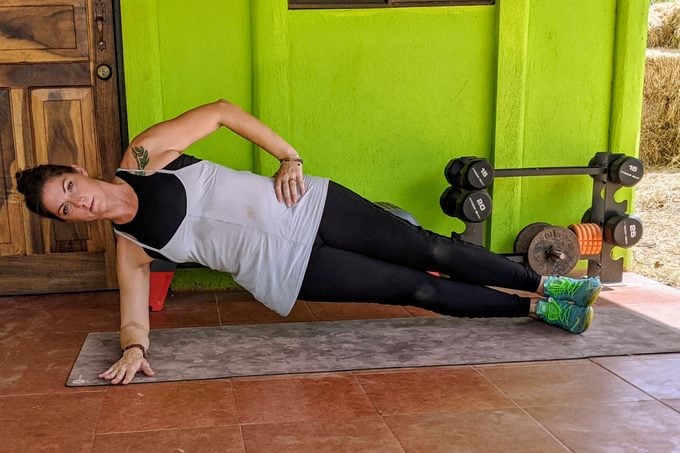 Side plank
Side plank
The side plank is a variation of the traditional plank but helps improve side-to-side stabilization and strength of the stabilizers of the shoulders and hips. It also further targets your abdominals and spinal erectors to hold the position.
How to do it
Lie on your right side on a mat, your legs stacked on top of each other, your torso “propped up” by your forearm. Your right elbow should be directly under your right shoulder, with your right forearm and palm flat on the ground.
From this position, take a breath in and engage your core, tightening up your abdomen, low back, and the stabilizers in your hips and shoulders before you press your hips up (using your core to lift your hips and torso) until you’re balanced on nothing more than your right forearm and the outside of your right foot.
If this is too challenging, you can place your left foot flat on the ground in front of your right leg (knee bent) to help provide extra stabilization. Your body should form a straight, diagonal line from the center of your forehead to the top of your right foot.
Hold the position for 20 to 60 seconds (as long as you can without allowing your hips to sag), release and rest for 30 seconds, then repeat two to three more times. If you need to, you can bend both knees and perform the side plank balanced on your forearm and right knee (legs stacked) rather than on your forearm and right foot.
(Here are more plank exercises to try.)
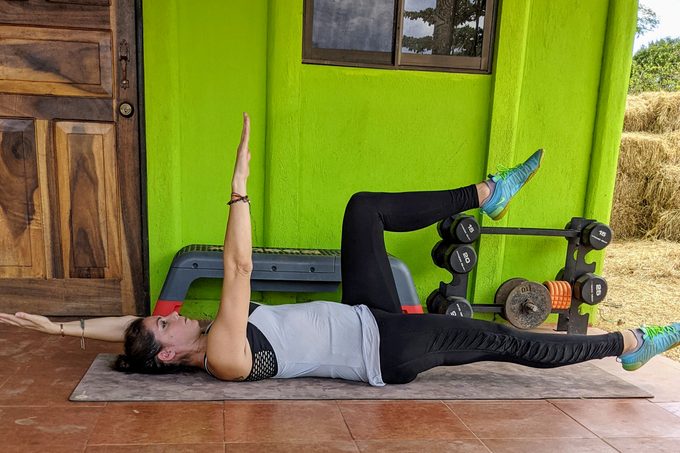 Dead bugs
Dead bugs
Dead bugs help work on alternate-side coordination (an important aspect of athletic movement) while helping increase endurance and strength through the pelvis and deep, stabilizing muscles of the core.
How to do it
Lie on your back, your knees bent, your feet flat on the ground, with your arms at your sides. Engage your core and create a neutral spine so your low back is pressed into the floor.
From here, lift your arms so they’re pointing straight up from your shoulders, and lift your feet from the floor so your knees are aligned directly over your hips. Your hips and your knees should form 90-degree angles.
From this position, with your core remaining engaged and your low back remaining in contact with the ground (you don’t want your hips or your shoulders to start shifting from side-to-side), simultaneously extend your right leg as you reach your left arm behind you toward the floor.
When your right heel and left hand are a few inches from the ground, draw them back to center and repeat on the opposite side. This is a single rep. Complete 10 to 15 repetitions. Rest, then perform two more sets. Breathe steadily throughout the exercise.
(Here’s how these women got their six-pack abs.)
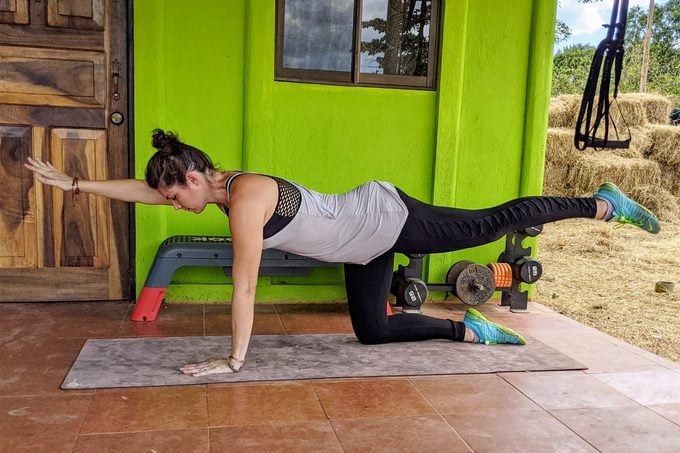 Bird dogs
Bird dogs
Bird dogs end up looking like the reverse exercise of dead bugs. Essentially, they also work on alternate-side coordination and stabilization of the core, but with greater focus on the back half of the body, including the glutes, spinal erectors, and even the upper back, neck, and shoulders.
How to do it
Set up on a mat on your hands and knees so your palms are directly under your shoulders and your knees are directly under your hips. Check to make sure your neck is aligned with your spine. (It shouldn’t be hanging between your arms or craned to look forward.)
Engage your core, tucking your hips to create that neutral spine. If you had a broomstick, it should be able to balance in a straight line along your spine from the back of your head to your tailbone.
From this position, in a single unit, lift your left arm and right leg, until they’re fully extended from your hip and shoulder. Hold for a beat, then return them to the mat. Repeat to the opposite side.
This is a single repetition. Complete a total of 10 to 15 repetitions, rest for 30 seconds, then complete two more sets.
One thing to remember is that your hips and shoulders should remain steady and squared to the floor—they shouldn’t twist or rotate, throwing your core out of alignment. Breathe steadily throughout the exercise.
(Do your hips feel achy? Try these stretches for hip pain.)
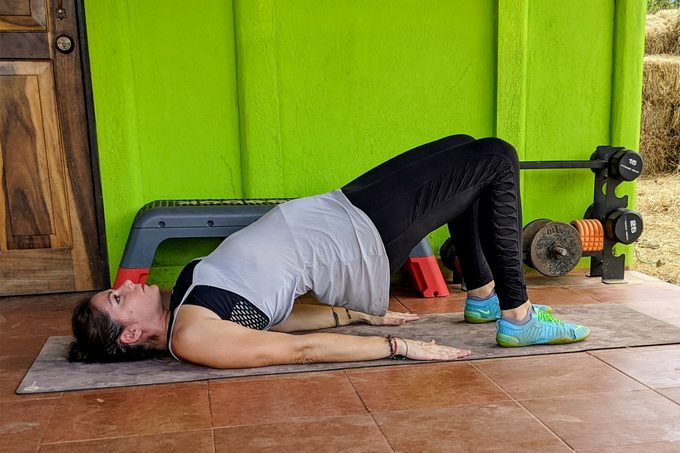 Bridge
Bridge
The bridge exercise works on core activation and glute strength as well as stabilization through the pelvis and hips. You can perform the exercise actively (for repetitions) or as a static hold (for time).
How to do it
Lie on your back on a mat with your knees bent, your feet flat on the floor, your arms extended by your sides. Engage your core, contracting all the muscles between your pelvis and shoulders, and create a neutral spine so your low back is in contact with the mat.
From this position, press through your heels, contract your glutes and press your hips from the mat until your body forms a straight, diagonal line from your knees to your shoulders.
If performing a static hold, maintain this position, breathing steadily, for 30 to 60 seconds. Lower your hips to the floor, rest for 30 seconds, then repeat two to four more sets.
If performing the bridge for repetitions, hold the lifted position for a beat, then reverse the movement, lowering your hips back to the floor, stopping just before your hips touch down. This is a single rep. Perform 15 to 20 repetitions, rest for 30 seconds, then perform two to three more sets.
Next, try these butt exercises.










